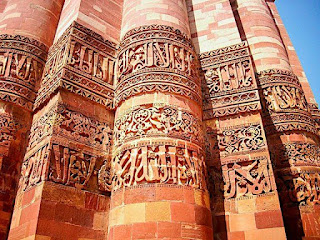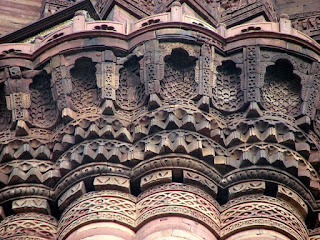Indo-Islamic Architecture
Indo-Islamic Architecture
By the end of 12th Century AD
the Islamic rule begin in India. In Indian architecture new elements were introduced
that includes: use of shapes (instead of natural forms); inscriptional art using decorative lettering or calligraphy; inlay decoration and use of coloured marble, painted plaster and brilliantly glazed tiles. In contrast to the indigenous Indian architecture which was of the trabeate order i.e. all spaces were spanned by means of horizontal beams, the Islamic architecture was arcuate i.e. an arch or dome was adopted as a method of bridging a space. The concept of arch or dome was not invented by the Muslims but was, in fact, borrowed and was further perfected by them from the architectural styles of the post-Roman period. The Muslims used the cementing agent in the form of mortar for the first time in the construction of buildings in India. They further put to use certain scientific and mechanical formulae, which were derived by experience of other civilizations, in their constructions in India. Such use of scientific principles helped not only in obtaining greater strength and stability of the construction materials but also provided greater flexibility to the architects and builders. This amalgamation of the Indian and the Islamic elements led to the emergence of a new style of architecture called the Indo-Islamic Architecture.
 One fact that must be stressed here is that, the Islamic elements of architecture had already passed through different experimental phases in other countries like Egypt, Iran and Iraq before these were introduced in India. Unlike most Islamic monuments of these countries, which were largely constructed in brick, plaster and rubble, the Indo-Islamic monuments were typical mortar-masonry works formed of dressed stones. It must be emphasized that the development of the Indo-Islamic architecture was greatly facilitated by the knowledge and skill possessed by the Indian craftsmen, who had mastered the art of stonework for centuries and used their experience while constructing Islamic monuments in India.
One fact that must be stressed here is that, the Islamic elements of architecture had already passed through different experimental phases in other countries like Egypt, Iran and Iraq before these were introduced in India. Unlike most Islamic monuments of these countries, which were largely constructed in brick, plaster and rubble, the Indo-Islamic monuments were typical mortar-masonry works formed of dressed stones. It must be emphasized that the development of the Indo-Islamic architecture was greatly facilitated by the knowledge and skill possessed by the Indian craftsmen, who had mastered the art of stonework for centuries and used their experience while constructing Islamic monuments in India.



Well written
ReplyDeleteNice
ReplyDeleteVery well written
ReplyDelete